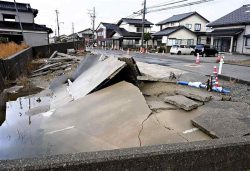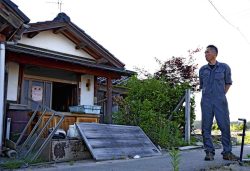Experts finds liquefaction made surfaces move up to 3 meters in Japan’s Noto Peninsula Earthquake

A road is seen to have risen due to liquefaction in Uchinada, Ishikawa Prefecture, on Tuesday.
15:33 JST, January 14, 2024
Ground bases in Uchinada, Ishikawa Prefecture, slid horizontally by as much as three meters because of the liquefaction phenomenon during the Noto Peninsula Earthquake, according to inspections by the Japanese Geotechnical Society.
Liquefaction refers to phenomenon in which earthquake tremors loosen bonds among sand grains, and the sand moves as if it was floating in water.
As a result of the large-scale lateral movement of the ground, many residential areas and road surfaces in the town rose or fell by large degrees.
A team of researchers who conducted the inspections found that the ground movement resulted in severe damage to houses and other structures in a wide area.
Sand dunes grew around town, leading the team of researchers to believe that the loose ground base in the area had an impact on the severity of the earthquake damage.
The inspections were conducted from Jan. 6 to 8. The results found that sand and water spouted out onto the surface in the Nishiaraya district of the town due to liquefaction.
In some locations, electric poles tilted and road surfaces rose by one meter or more from their original height.
Susumu Yasuda, a professor emeritus of Tokyo Denki University and an expert of geotechnical engineering who was a member of the team, said that lateral movement, where ground bases slide horizontally, was caused by liquefaction in the inspected sites.
Considering the size of cracks in the ground, Yasuda assumed that the ground bases moved by about three meters.
The team of researchers also confirmed lateral movement in the Osaki district in Kahoku, a city near Uchinada in the prefecture.
Lateral movement due to liquefaction attracted attention in the aftermath of the 1983 Sea of Japan earthquake. In the 1995 Great Hanshin Earthquake, houses and transportation networks near quay walls suffered serious damage due to the phenomenon.
Liquefaction tends to occur in reclaimed coastal land. At the time of the Great East Japan Earthquake, damage happened when the upheaval of manholes occurred in bay areas of Chiba Prefecture and other regions.
Yasuda said, “The damage to houses [in the Noto Peninsula Earthquake] is more serious than those in the past. The situation will likely have a large impact on survivors’ ability to restore their livelihood.”
"Society" POPULAR ARTICLE
-

M4.9 Earthquake Hits Tokyo, Neighboring Prefectures
-

Israeli Tourists Refused Accommodation at Hotel in Japan’s Nagano Pref., Prompting Protest by Israeli Embassy and Probe by Prefecture
-

M7.5 Earthquake Hits Northern Japan; Tsunami Waves Observed in Hokkaido, Aomori and Iwate Prefectures
-

Tsukiji Market Urges Tourists to Avoid Visiting in Year-End
-

High School in Kyoto Says Students Shoplifted during Recent School Trip to Bali, Indonesia
JN ACCESS RANKING
-

Tokyo Economic Security Forum to Hold Inaugural Meeting Amid Tense Global Environment
-

Keidanren Chairman Yoshinobu Tsutsui Visits Kashiwazaki-Kariwa Nuclear Power Plant; Inspects New Emergency Safety System
-

Imports of Rare Earths from China Facing Delays, May Be Caused by Deterioration of Japan-China Relations
-

University of Tokyo Professor Discusses Japanese Economic Security in Interview Ahead of Forum
-

Japan Pulls out of Vietnam Nuclear Project, Complicating Hanoi’s Power Plans


























